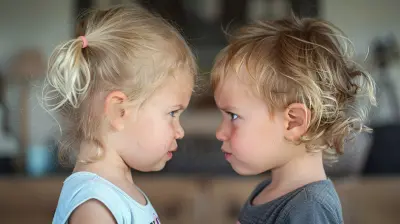Encouraging Teamwork and Collaboration in Learning
7 September 2025
Let’s be real—learning's tough when you're doing it all by yourself. Think about the number of times you've cracked a tricky problem or come up with a creative idea after simply talking it out with someone else. That’s the magic of teamwork and collaboration. And when it comes to our kids? That magic multiplies.
In today’s world, the ability to work well with others isn't just a "nice-to-have"—it's a must. No matter what path our children take—science, art, tech, or even business—they’ll need to know how to collaborate. So how do we, as parents and caregivers, raise team players in a world that often celebrates individual achievements?
Buckle up, because we’re diving into just that.
Why Teamwork in Learning Matters More Than Ever
Gone are the days when success was measured solely by individual accomplishments. These days, schools, workplaces, and even everyday life thrive on collaboration. Teaching our children how to work well with others sets them up for academic success, yes—but also for lifelong personal and professional wins.Let’s break it down.
Teamwork Builds Communication Skills
You know that awkward moment when you have to explain your thoughts, only to realize you don’t actually understand them well yourself? Kids go through this too. Working in teams forces them to articulate their ideas clearly—whether verbally or through other forms like writing or drawing.Collaboration Sparks Creativity
When kids exchange ideas, it’s like mixing colors in a paint palette. You start with red and blue, and suddenly—boom—you’ve got purple. Group learning opens a world of perspectives, helping children think outside of their own boxes.It Builds Empathy and Emotional Intelligence
Collaboration isn’t just about sharing ideas. It’s about understanding others. Kids learn that their teammate might be having a tough day or that someone else’s idea might actually be better than their own. Emotional growth like this? Priceless.
The Challenges of Teaching Teamwork (And How to Overcome Them)
Let’s not pretend—it’s not always sunshine and rainbows. Kids aren’t naturally born knowing how to work well in groups. In fact, they’re often fiercely independent or overly passive. So what gets in the way?Problem #1: Dominant vs. Passive Roles
Some kids take charge, while others shrink into the background. When this happens, learning isn’t balanced. One child might feel overwhelmed, while another checks out completely.Solution: Rotate leadership roles in group activities. Let the quiet one lead a discussion. Have the outspoken one take notes. Structure helps balance dynamics.
Problem #2: Lack of Accountability
It’s easy to point fingers in a group setting. "He didn’t do anything!" Sound familiar?Solution: Use group contracts or responsibility charts. When every kid knows their role and task, there’s less room for blame—and more room for growth.
Problem #3: Miscommunication
Kids often assume others know what they’re thinking. Spoiler alert: They don’t.Solution: Encourage specific feedback and open-ended questions. Instead of “That’s wrong,” have them say, “I see you did it this way—how did you come to that answer?”
Practical Ways to Encourage Teamwork at Home
We're not all teachers (though we sometimes feel like it!), but we can absolutely nurture collaboration skills right at home.Family Game Nights
You’d be surprised at how much teamwork learning comes from a simple board game. Think games like Pictionary, Codenames, or even escape room board games where teamwork is the goal.While your kids are laughing and strategizing, they're also learning to listen, negotiate, and trust each other.
Cooking Together
Teamwork in the kitchen? Oh, it's real. One child can measure ingredients, another stirs, while someone reads the recipe. You’re helping them practice planning, division of labor, and communication—all while creating delicious memories.Group Chore Challenges
Let’s face it—chores are boring. But turn them into group "missions," and suddenly they're a chance for teamwork. Create a weekly "clean-up squad," assign roles, and celebrate the win together.
Boosting Collaboration in the Classroom
Now, let’s talk school. Most of your child’s time revolves around it, so it's crucial that teamwork isn’t just encouraged—it’s embedded.Project-Based Learning
This one’s a classroom favorite for a reason. In a good project setup, kids rely on each other to bring the project to life—each one with a unique role. The collaboration becomes authentic, not forced.If your child’s teacher isn’t already using this method, don’t hesitate to suggest it. Teachers love parental input that adds value.
Peer Reviews and Study Buddies
Exchanging work and feedback with others helps students see how different minds solve the same problem. Forming study buddy systems can also build trust and a sense of responsibility.Seating Arrangements That Promote Discussion
Believe it or not, even where a child sits can influence their collaborative skills. U-shaped seating, group tables, or even standing whiteboard zones can lead to natural discussions and teamwork.What Role Do Teachers and Parents Play?
A huge one.As adults, we set the tone. Kids observe more than we realize. So if they see us collaborating respectfully with others—be it co-workers, family members, or even strangers—they’re more likely to mimic that behavior.
Model It Yourself
Next time you face a problem, invite your child into the solution. Say something like, “I'm working on planning your birthday party and I’m feeling a bit stuck. Can you help me brainstorm ideas?” Boom—instant collaboration practice.Celebrate Effort, Not Just Outcome
Rather than saying “Good job on the A,” say, “I loved how you and your group worked through that tricky science project together. That must’ve taken a lot of cooperation.”Ask Reflective Questions
After any group activity, ask your child:- What did your team do well?
- Was there a moment you disagreed? How did you handle it?
- What role did you enjoy the most?
Reflection builds self-awareness—and deepens collaborative skills.
Encouraging Teamwork Through Technology
Let’s face it—tech isn't going away. So let's use it to our advantage.Apps and Platforms that Promote Collaboration
Apps like Google Docs, Padlet, and Canva allow students to co-create in real time. These tools teach organization, time management, and shared responsibility.Educational Games and Simulations
Games like Minecraft Education Edition or cooperative logic games let kids solve problems together in a fun, low-pressure environment.When Teamwork Goes South: How to Help Kids Navigate Conflict
Conflict isn’t the enemy of collaboration—it’s an essential part of it. The goal isn’t to eliminate disagreements but to teach kids how to handle them like champs.Teach “I” Statements
Instead of “You're being unfair,” encourage “I feel frustrated when…” This small shift opens doors for empathy instead of blame.Practice Role-Playing
Act out common group conflicts and let your child practice different responses. Yes, it might feel silly at first, but it works.Reinforce the Idea of Flexibility
Kids need to understand that every team effort requires give-and-take. Sometimes their idea won’t be chosen—and that’s OK! Being adaptable is a superpower.Collaboration Beyond the Classroom
Teamwork isn’t confined to school or homework. It shows up in sports teams, neighborhood play, and even online communities.Get Them Involved in Team Activities
Sports, music bands, coding clubs, theater groups—each of these environments naturally teaches teamwork. Plus, they’re fun, which means the lessons stick.Create Family Projects
Start a mini garden together. Build a treehouse. Organize a garage sale. The more real-life collaborative experiences you can provide, the more your child absorbs how to work with others.Wrapping It All Up
Look, collaboration isn't an overnight skill—it’s a lifelong art. But if we intentionally create environments (both at home and in school) that encourage teamwork, we raise not just smart kids, but kind, capable, and cooperative humans.The world doesn’t need more solo stars. It needs dream teams. And your child? They can absolutely be a stellar teammate—with just a little nudging in the right direction.
So next time they squabble over a group project or complain about a stubborn classmate, lean in. Those moments? They’re gold mines for teaching, growing, and yes—collaborating.
all images in this post were generated using AI tools
Category:
Education TipsAuthor:

Max Shaffer
Discussion
rate this article
1 comments
Maris Simmons
Great insights! I'm eager to explore how teamwork can transform my child's learning experience and creativity!
September 15, 2025 at 2:27 AM

Max Shaffer
Thank you! Embracing teamwork can indeed unlock new dimensions of creativity and learning. Excited for you to explore this!


